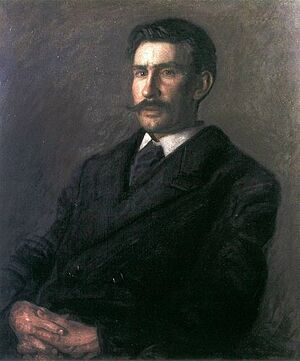Edward Willis Redfield facts for kids
Quick facts for kids
Edward Willis Redfield
|
|
|---|---|

Portrait of Edward W. Redfield by Thomas Eakins
|
|
| Born | December 18, 1869 Bridgeville, Delaware, U.S.
|
| Died | October 19, 1965 (aged 95) |
| Nationality | American |
| Education | Pennsylvania Academy of the Fine Arts, Académie Julian, École des Beaux-Arts |
| Known for | Impressionism, Landscape art |
Edward Willis Redfield (born December 18, 1869 – died October 19, 1965) was a famous American Impressionist painter. He was known for his beautiful landscape paintings. Redfield was part of an art colony in New Hope, Pennsylvania. He is most famous for his paintings of snowy scenes around New Hope. He also spent summers in Boothbay Harbor, Maine, painting the coast and Monhegan Island.
Contents
Life and Art of Edward Redfield
Early Life and Training
Edward Redfield was born in 1869 in Bridgeville, Delaware. He showed a talent for art when he was young. From 1887 to 1889, he studied painting in Philadelphia. He attended the Pennsylvania Academy of the Fine Arts.
His teachers there included Thomas Anshutz and Thomas Hovenden. Anshutz taught a style that focused on studying the human body. At the Academy, Redfield became good friends with Robert Henri. Henri later became a very important American painter and teacher.
Studying in France
Redfield and Robert Henri traveled to France to continue their art studies. They attended famous schools like the Académie Julian and the École des Beaux-Arts. There, they learned from William Adolphe Bouguereau, a well-known French painter.
In Europe, Redfield admired the work of Impressionist painters. These included Claude Monet and Camille Pissarro. He also liked the Norwegian artist Fritz Thaulow. While in France, Redfield met Elise Deligant, and they got married in 1893.
The New Hope Art Colony
In 1898, Redfield and his wife moved back to America. They settled in Centre Bridge, Pennsylvania, near New Hope. He was one of the first artists to live in this area. He is often seen as a co-founder of the New Hope art colony. William Langson Lathrop also moved there the same year.
Redfield became a leader among the landscape painters in the area. These artists lived near the Delaware River in Pennsylvania. Many people felt his art was truly American. It did not just copy the style of French Impressionists.
Art critics praised Redfield's unique American style. One critic, Guy Pene Du Bois, said Redfield's group was "our first truly national expression." Another, J. Nilsen Laurvik, called him a "standard bearer" for American landscape painting.
Influence on American Art
Redfield and his group had a big impact on American landscape painting. Other artists looked up to them. Emile Gruppe, a later landscape painter, remembered seeing Redfield's work. He said Redfield, Daniel Garber, and Elmer Schofield "dominated the walls" of major art shows.
Philadelphia did not become a big center for Impressionist painters. Instead, the main "school" of Impressionism grew around New Hope. Edward Redfield was the central figure of this group. These artists preferred the quiet, rural Bucks County over busy cities.
Painting City Scenes
Even though he loved nature, Redfield also painted cities. In 1909, he spent about six months in New York City. He created a group of important city views. These were large, wide paintings that showed the mood of the city.
Unlike some of his friends who painted everyday city life, Redfield focused on grand views. His paintings showed majestic scenes, often with tiny figures. One of his largest city paintings, "Between Daylight and Darkness," is a famous example.
Redfield's Painting Style
Edward Redfield's Impressionist landscapes are known for their bold paint and bright colors. He painted en plein air, which means outdoors, directly from nature. He did not paint in a studio.
He used thick layers of paint, often finishing a painting in one session. He would paint outdoors, even in harsh winter weather. He sometimes tied his large canvases to trees so they wouldn't blow away! He became known as the leading American painter of winter scenes in the 20th century.
Redfield won more awards than almost any other American painter. His works were shown across the country. In 1915, twenty-seven of his paintings were featured at a big art event in San Francisco.
Spring and Summer Scenes
In the late 1910s, Redfield started painting spring scenes. These also used his thick paint style, similar to his snow scenes. He had a studio in Point Pleasant, near the Delaware River. He painted several spring scenes there.
One example is "Road to the River" from around 1920. It shows early spring in the Delaware Valley. A girl walks with her ducks as trees begin to blossom. This girl might be one of his daughters, Louise or Elise. While he was famous for winter scenes, his spring paintings are highly valued today.
Starting in 1903, Redfield and his wife and five children spent summers in Boothbay Harbor, Maine. A friend helped pay for these trips. Redfield eventually bought a home there. It was a charming fishing village. He even designed a special dining table for eating lobsters!
Later Years
In his later years, Redfield became unhappy with some of his older paintings. In 1947, he burned many of his early or damaged works. He stopped painting completely in 1953.
Redfield explained why he stopped. He said, "I was outside one day. My insteps started hurting. It was very windy and I had a hard time keeping my easel up. So I quit." He also felt his work wasn't as good as it used to be. He didn't want to put his name on "old man's stuff."
Edward Redfield passed away on October 19, 1965. Today, his paintings are in many major museums. These include the Metropolitan Museum of Art in New York City and the Smithsonian American Art Museum in Washington, DC.


